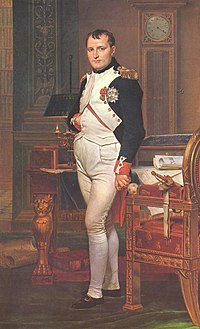
Back Napoleontiese Oorloë Afrikaans الحروب النابليونية Arabic حروب نابوليون ARZ Guerres napoleóniques AST Napoleon müharibələri Azerbaijani ناپلئون ساواشلاری AZB Напалеонаўскія войны Byelorussian Напалеонаўскія войны BE-X-OLD Наполеонови войни Bulgarian নেপোলিয়নীয় যুদ্ধ Bengali/Bangla
| Napoleonic Wars | |||||||
|---|---|---|---|---|---|---|---|
 Battle of Waterloo | |||||||
| |||||||
| Belligerents | |||||||
|
French Empire and allies: French clients: | ||||||
| Commanders and leaders | |||||||
|
George III Duke of Wellington Horatio Nelson † Francis II Alexander I Mikhail Kutuzov Michael de Tolly Pyotr Bagration † Gustav IV Adolf Charles XIII Charles XIV John John VI Ferdinand I Friedrich Wilhelm III Fernando VII Louis XVIII William I of Netherlands William II of Netherlands |
Napoleon Jean-de-Dieu Soult Louis-Nicholas Davout Andre Massena Michel Ney Louis Bonaparte Eugene de Beauharnais Charles IV of Spain Joachim Murat Friedrich August I Józef Poniatowski † Maximillien I Joseph [[Jerome Bonaparte | ||||||
| Strength | |||||||
| |||||||
| Casualties and losses | |||||||
| |||||||
|
Total 3,707,000+ military and civilians killed
| |||||||

The Napoleonic Wars were fought during the rule of Napoleon Bonaparte over France. They started after the French Revolution ended, and Bonaparte became powerful in France in November 1799. War restarted between the United Kingdom and France in 1803 despite the Treaty of Amiens.
The wars changed European military systems. Cannons became lighter and moved faster. Armies were much larger but had better food and supplies and were very large and destructive, mainly because of compulsory conscription. The French became powerful very fast and conquered most of Europe but then lost quickly after the French invasion of Russia failed.
The Napoleonic Wars ended with the Second Treaty of Paris on 20 November 1815, just after the huge Battle of Waterloo, a large battle that the French lost. Napoleon was sent into exile, and the House of Bourbon ruled France again.
Some people call the time between 20 April 1792 and 20 November 1815 "the Great French War".
On one side were the France, the Kingdom of Italy and others. On the other side were Great Britain, Prussia, Austria, Russia, Sweden, Portugal, Spain, Sicily, and others.
Cite error: There are <ref group=lower-alpha> tags or {{efn}} templates on this page, but the references will not show without a {{reflist|group=lower-alpha}} template or {{notelist}} template (see the help page).
- ↑ Arnold, James R. (1995). Napoleon Conquers Austria: The 1809 Campaign for Vienna. Greenwood Publishing Group. p. 36. ISBN 978-0-275-94694-4.
- ↑ The Austrian Imperial-Royal Army (Kaiserliche-Königliche Heer) 1805 – 1809: The Hungarian Royal Army The Austrian Imperial-Royal Army Kaiserliche-Königliche Heer): 1805 – 1809
- ↑ Todd Fisher: The Napoleonic Wars: The Empires Fight Back 1808–1812, Oshray Publishing, 2001 [1] Archived 2015-09-30 at the Wayback Machine
- ↑ John Sainsbury (1842). Sketch of the Napoleon Museum. London. p. 15.
- ↑ Reich 1905, p. 622
- ↑ "Denmark". World Statesmen. Retrieved 18 January 2015.
- ↑ "Norway". World Statesmen. Retrieved 18 January 2015.
- ↑ Benjamin Keen and Keith Haynes, A History of Latin America (2012) ch 8
- ↑ Schafer, Anton (2002). Zeittafel der Rechtsgeschichte: von den Anfangen uber Rom bis 1919 mit Schwerpunkt Osterreich und zeitgenossischen Bezugen ; [mit uber 1400 Jahresdaten (mehr als 2000 Eintragungen) und 39 Seiten mit Stichwortern fur die effiziente Suche von 10000 v.d.Zw. bis 1919 n.d.Zw.] EDITION EUROPA Verlag. p. 137. ISBN 3-9500616-8-1.
- ↑ Edward et al., pp. 522–524
- ↑ "De Grondwet van 1815". Parlement & Politiek (in Dutch). Retrieved 26 June 2014.
- ↑ Dwyer, Philip G. (2014). The Rise of Prussia 1700-1830. Routledge. p. 255. ISBN 978-1-317-88703-4.
- ↑ Collier, Martin (2003). Italian unification, 1820–71. Heinemann Advanced History (First ed.). Oxford: Heinemann. p. 2. ISBN 978-0-435-32754-5.
The Risorgimento is the name given to the process that ended with the political unification of Italy in 1871
- ↑ Riall, Lucy (1994). The Italian Risorgimento: state, society, and national unification (First ed.). London: Routledge. p. 1. ISBN 978-0-203-41234-3.
The functional importance of the Risorgimento to both Italian politics and Italian historiography has made this short period (1815–60) one of the most contested and controversial in modern Italian history
- ↑ Jakob Walter, and Marc Raeff. The diary of a Napoleonic foot soldier. Princeton, N.J., 1996.
- ↑ Martyn Lyons p. 234–36
- ↑ Payne 1973, pp. 432–433.
- ↑ Esdaile 2008.
- ↑ Riehn 1991, p. 50.
- ↑ Chandler & Beckett, p. 132
- ↑ Blücher, scourge of Napoleon, Leggiere
- ↑ France, John (2011). Perilous Glory: The Rise of Western Military Power. Yale UP. p. 351. ISBN 978-0-300-17744-2.
- ↑ Napoleon, Fondation (2012). Correspondance generale - Tome 12. Fayard. ISBN 978-2-213-67272-4.
- ↑ 25.0 25.1 White 2014, Napoleonic Wars cites Urlanis 1971
- ↑ Canales 2004.
- ↑ White 2014 cites Payne
- ↑ 28.0 28.1 White 2014 cites Dumas 1923 citing Hodge
- ↑ 29.0 29.1 29.2 White 2014 cites Danzer
- ↑ White 2014 cites Clodfelter
- ↑ White 2014 cites Bodart 1916
- ↑ 32.0 32.1 32.2 Philo 2010.